heater CHEVROLET EXPRESS 1997 1.G User Guide
[x] Cancel search | Manufacturer: CHEVROLET, Model Year: 1997, Model line: EXPRESS, Model: CHEVROLET EXPRESS 1997 1.GPages: 386, PDF Size: 20.32 MB
Page 206 of 386
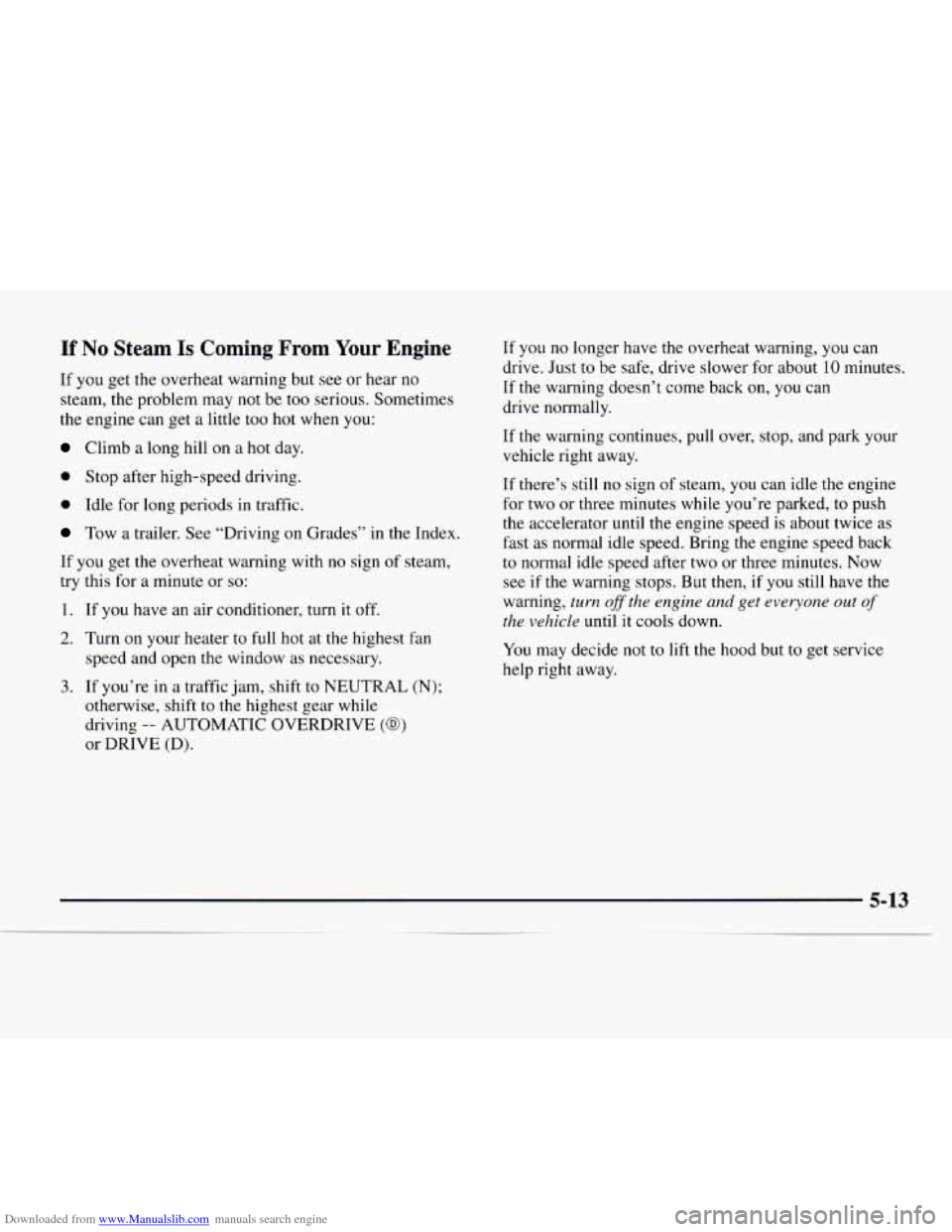
Downloaded from www.Manualslib.com manuals search engine If No Steam Is Coming From Your Engine
If you get the overheat warning but see or hear no
steam, the problem may not be too serious. Sometimes
the engine can get a little too hot when you:
Climb a long hill on a hot day.
0 Stop after high-speed driving.
0 Idle for long periods in traffic.
Tow a trailer. See “Driving on Grades’’ in the Index.
If
you get the overheat warning with no sign of steam,
try this for a minute
or so:
1. If you have an air conditioner, turn it off.
2. Turn on your heater to full hot at the highest fan
speed and open the window as necessary.
3. If you’re in a traffic jam, shift to NEUTRAL (N);
otherwise,
shift to the highest gear while
driving
-- AUTOMATIC OVERDRIVE (@)
or DRIVE (D). If
you no
longer have the overheat warning, you can
drive. Just to be safe, drive slower for about
10 minutes.
If the warning doesn’t come back on, you can
drive normally.
If the warning continues, pull over, stop, and park your
vehicle right away.
If there’s still no sign of steam, you can idle the engine
for two or three minutes while you’re parked, to push
the accelerator until the engine speed is about twice as
fast as normal idle speed. Bring the engine speed back
to normal idle speed after two or three minutes. Now
see if the warning stops. But then, if you still have the
warning,
turn ofsthe engine and get everyone out of
the vehicle until it cools down.
You may decide not to lift the hood but to get service
help right away.
Page 208 of 386
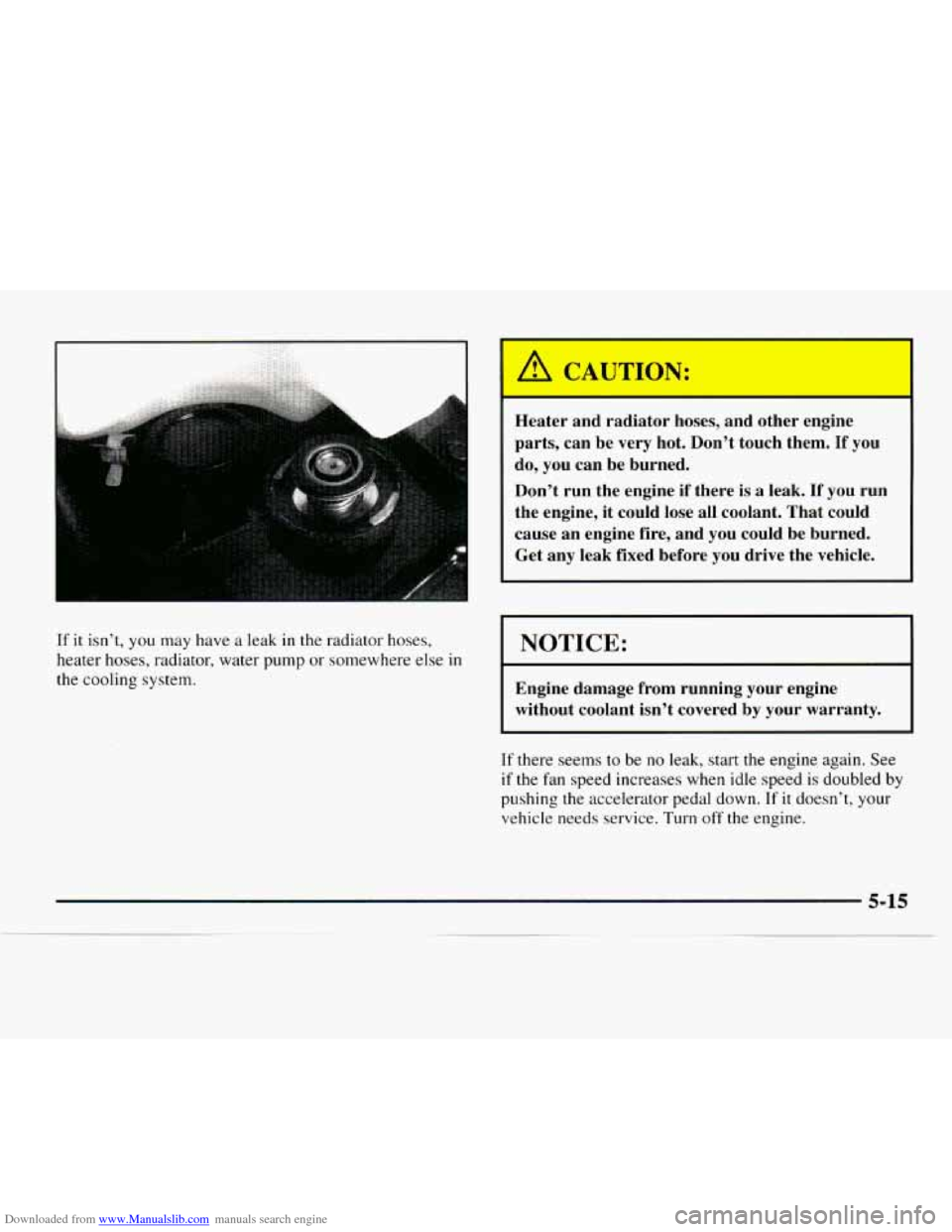
Downloaded from www.Manualslib.com manuals search engine If it isn’t, you may have a leak in the radiator hoses,
heater hoses, radiator, water pump or somewhere else
in
the cooling system. Heater and radiator
hoses, and other engine
parts, can be
very hot. Don’t touch them. If you
do, you can be burned.
Don’t run the engine if there
is a leak. If you run
the engine, it could lose all coolant. That could
cause an engine fire, and you could be burned.
Get any leak fixed before you drive the vehicle.
I NOTICE: I
Engine damage from running your engine
without coolant isn’t covered by your warranty.
If there seems
to be no leak, start the engine again. See
if the fan speed increases when idle speed is doubled by
pushing the accelerator pedal down.
If it doesn’t, your
vehicle needs service. Turn
off the engine.
Page 209 of 386
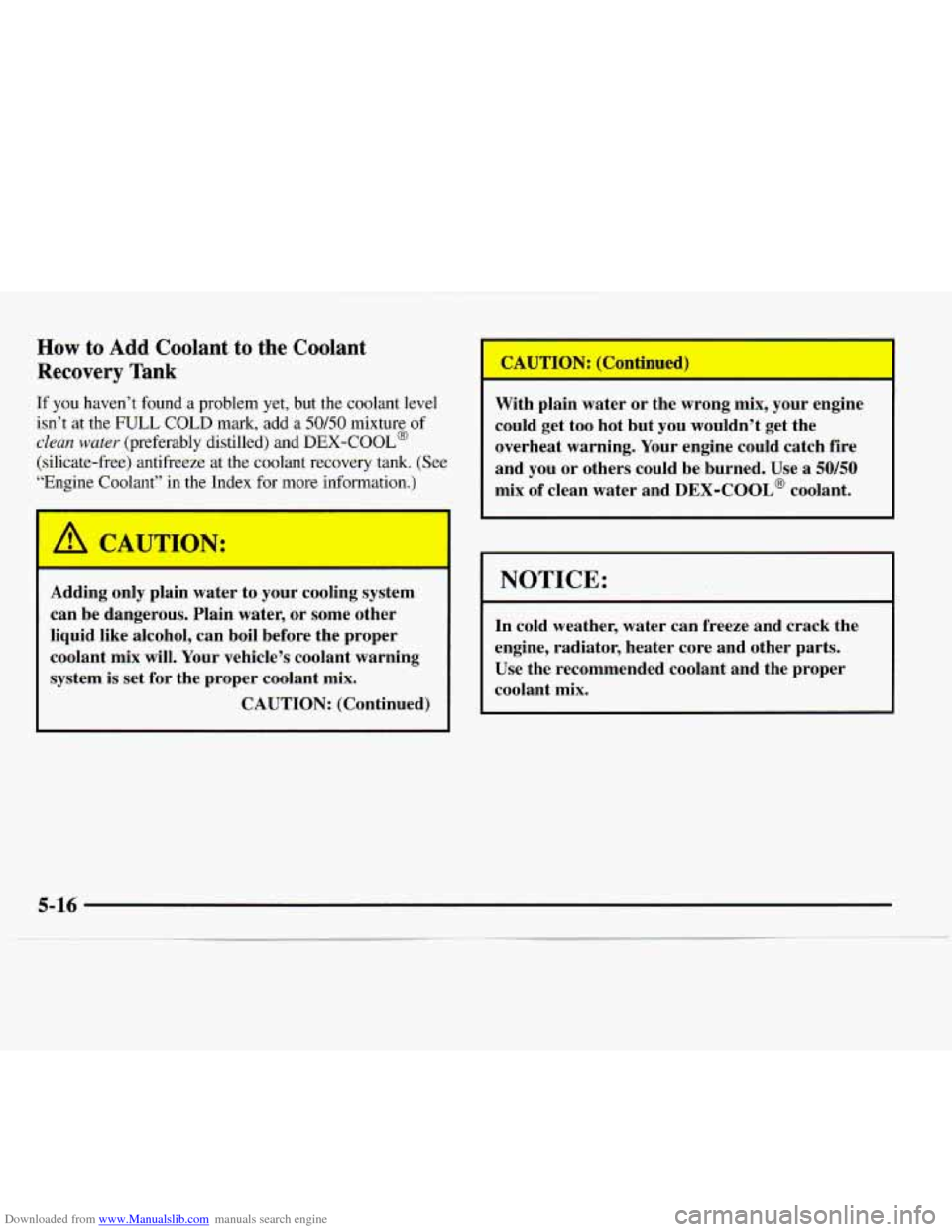
Downloaded from www.Manualslib.com manuals search engine How to Add Coolant to the Coolant
Recovery Tank
If you haven’t found a problem yet, but the coolant level
isn’t at the
FULL COLD mark, add a 50/50 mixture of
dean water (preferably distilled) and DEX-COOL@
(silicate-free) antifreeze at the coolant recovery tank. (See
“Engine Coolant” in the Index for more information.)
Adding only plain water to your cooling system
can be dangerous. Plain water, or some other
liquid like alcohol, can boil before the proper
coolant mix will. Your vehicle’s coolant warning
system is set for the proper coolant mix.
CAUTION: (Continued) With plain water
or the wrong mix, your engine
could get too hot but you wouldn’t get the
overheat warning. Your engine could catch fire
and you or others could be burned. Use
a 50/50
mix of clean water and DEX-COOL@ coolant.
I NOTICE:
In cold weather, water can freeze and crack the
engine, radiator, heater core and other parts.
Use the recommended coolant and the proper
coolant mix.
5-16
Page 256 of 386
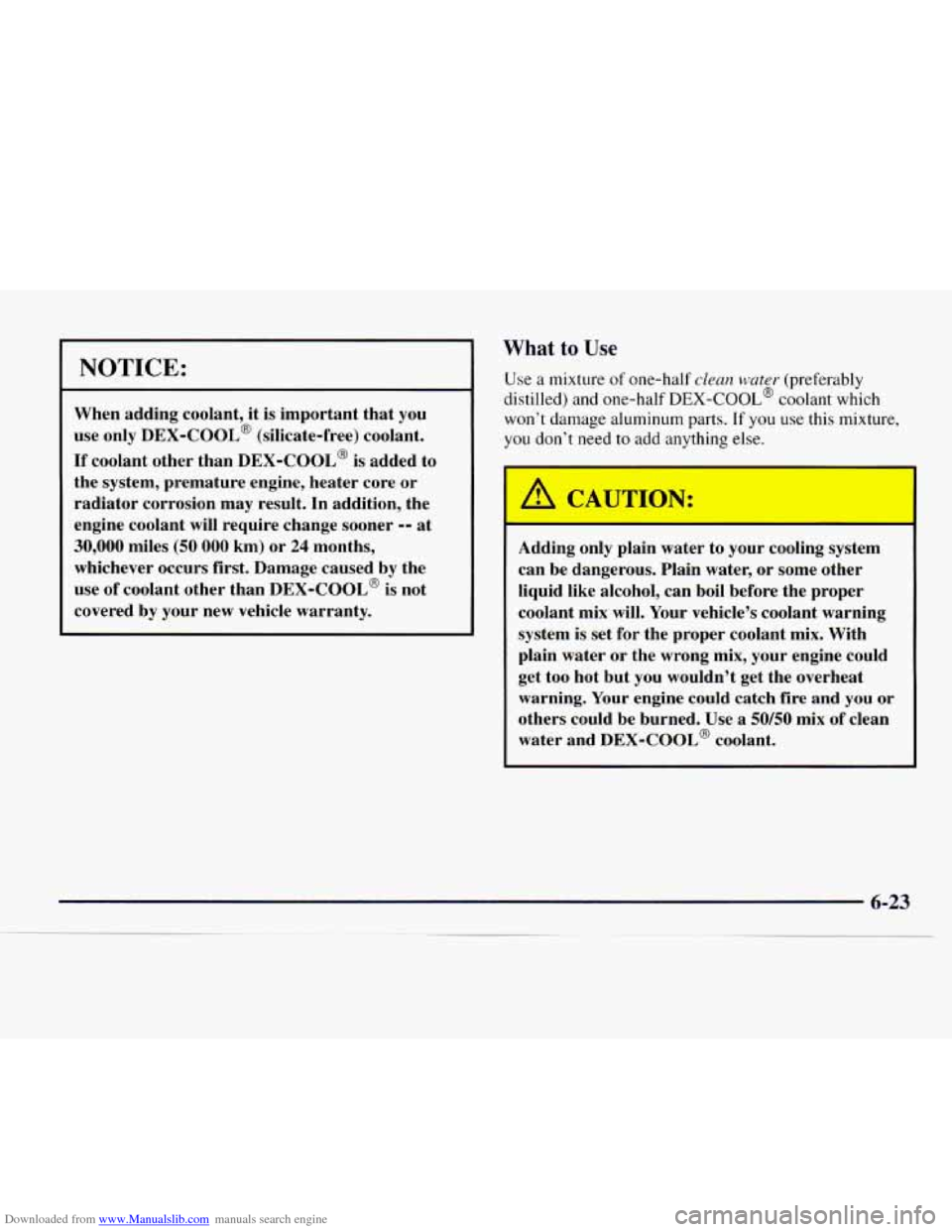
Downloaded from www.Manualslib.com manuals search engine NOTICE:
When adding coolant, it is important that you
use only
DEX-COOL@ (silicate-free) coolant.
If coolant other than DEX-COOL@ is added to
the system, premature engine, heater core or
radiator corrosion may result.
In addition, the
engine coolant will require change sooner
-- at
30,000 miles (50 000 km) or 24 months,
whichever occurs first. Damage caused by the
use of coolant other than DEX-COOL@ is not
covered by your new vehicle warranty.
What to Use
Use a mixture of one-half clean water (preferably
distilled) and one-half
DEX-COOL@ coolant which
won’t damage aluminum parts.
If you use this mixture,
you don’t need to add anything else.
I
I
Adding only plain water to your cooling system
can be dangerous. Plain water,
or some other
liquid like alcohol, can boil before the proper
coolant mix will. Your vehicle’s coolant warning
system is set for the proper coolant mix. With
plain water or the wrong mix, your engine could
get too hot but you wouldn’t get the overheat
warning. Your engine could catch fire and you or
others could be burned. Use a
50/50 mix of clean
water and DEX-COOL@ coolant.
Page 257 of 386
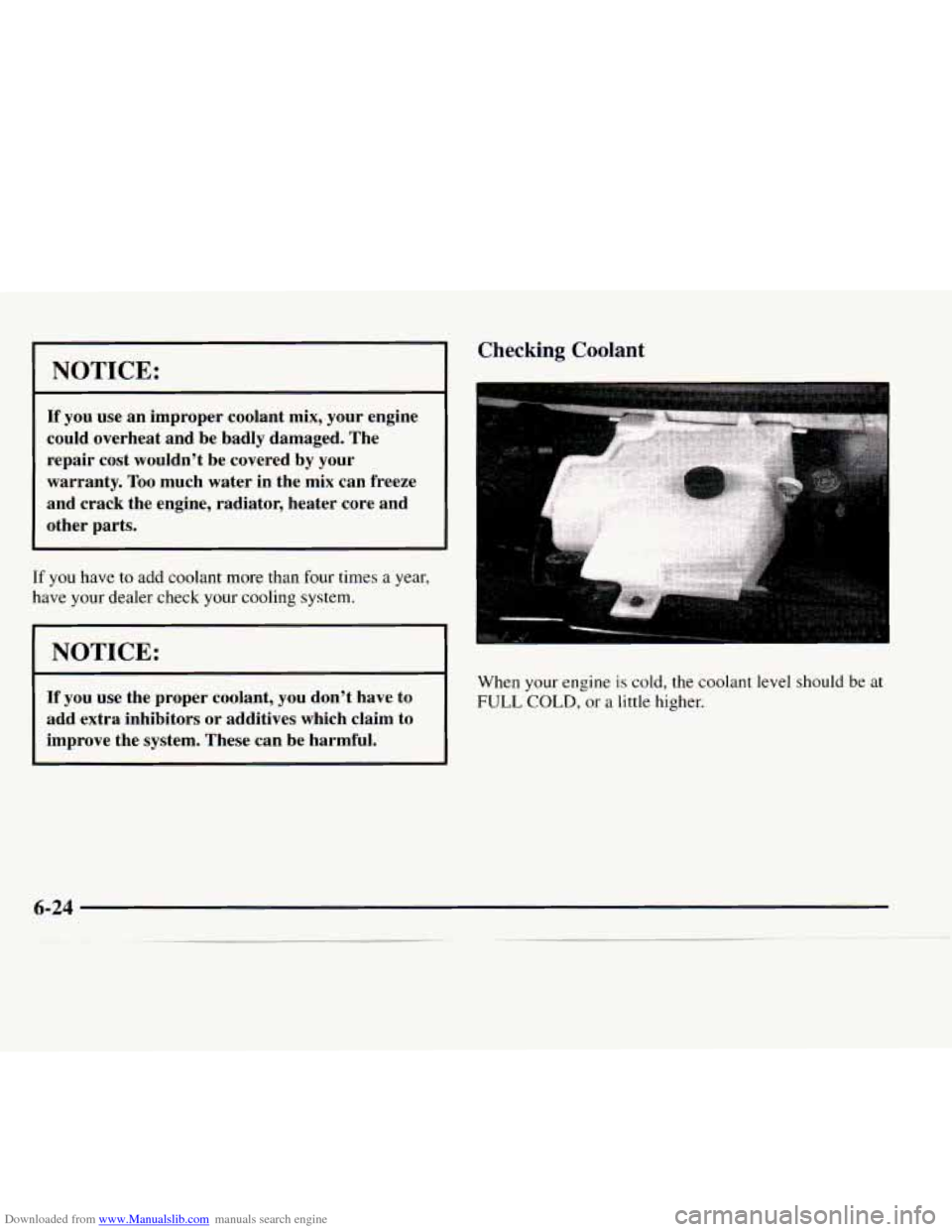
Downloaded from www.Manualslib.com manuals search engine NOTICE:
If you use an improper coolant mix, your engine
could overheat and be badly damaged. The
repair cost wouldn’t be covered by your
warranty.
Too much water in the mix can freeze
and crack the engine, radiator, heater core and
other parts.
If you have to add coolant more than four times a year,
have your dealer check your cooling
system.
1 NOTICE:
If you use the proper coolant, you don’t have to
add extra inhibitors or additives which claim to
improve the system. These can be harmful.
Checking Coolant
When your engine is cold, the coolant level should be at
FULL COLD, or a little higher.
Page 296 of 386
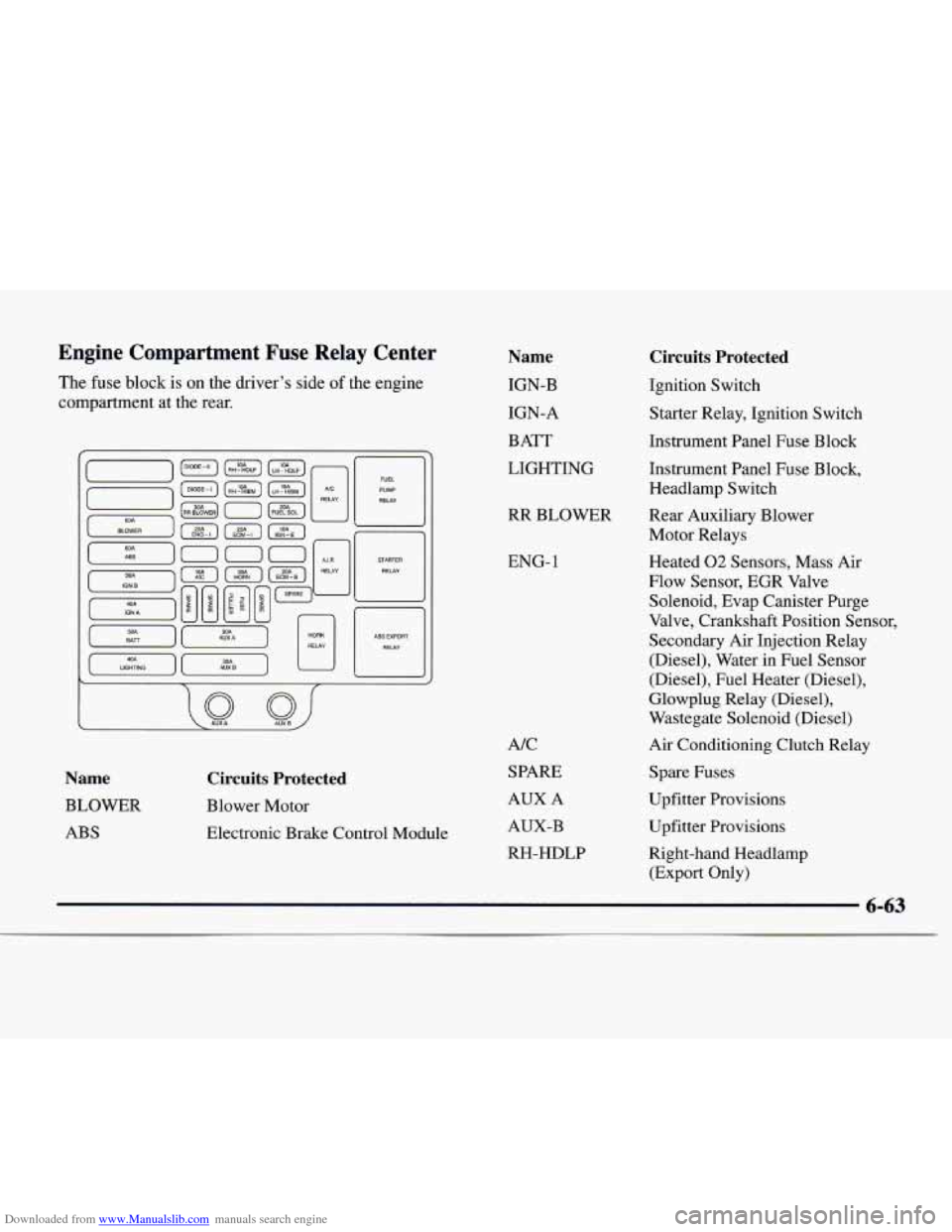
Downloaded from www.Manualslib.com manuals search engine Engine Compartment Fuse Relay Center
The fuse block is on the driver’s side of the engine
compartment at the rear.
,
[T)
Name
BLOWR
ABS
Circuits Protected
Blower Motor
Electronic Brake Control Module
Name
IGN-B
IGN-A
BATT
LIGHTING
RR BLOWER
ENG-
1
AIC
SPARE
AUX A
AUX-B
RH-HDLP
Circuits Protected
Ignition Switch
Starter Relay, Ignition Switch
Instrument Panel Fuse Block
Instrument Panel Fuse Block,
Headlamp Switch
Rear Auxiliary Blower
Motor Relays
Heated
02 Sensors, Mass Air
Flow Sensor, EGR Valve
Solenoid, Evap Canister Purge
Valve, Crankshaft Position Sensor,
Secondary Air Injection Relay
(Diesel), Water in Fuel Sensor
(Diesel), Fuel Heater (Diesel),
Glowplug
Relay (Diesel),
Wastegate Solenoid (Diesel)
Air Conditioning Clutch Relay
Spare Fuses
Upfitter Provisions
Upfitter Provisions
Right-hand Headlamp (Export Only)
6-63
Page 298 of 386
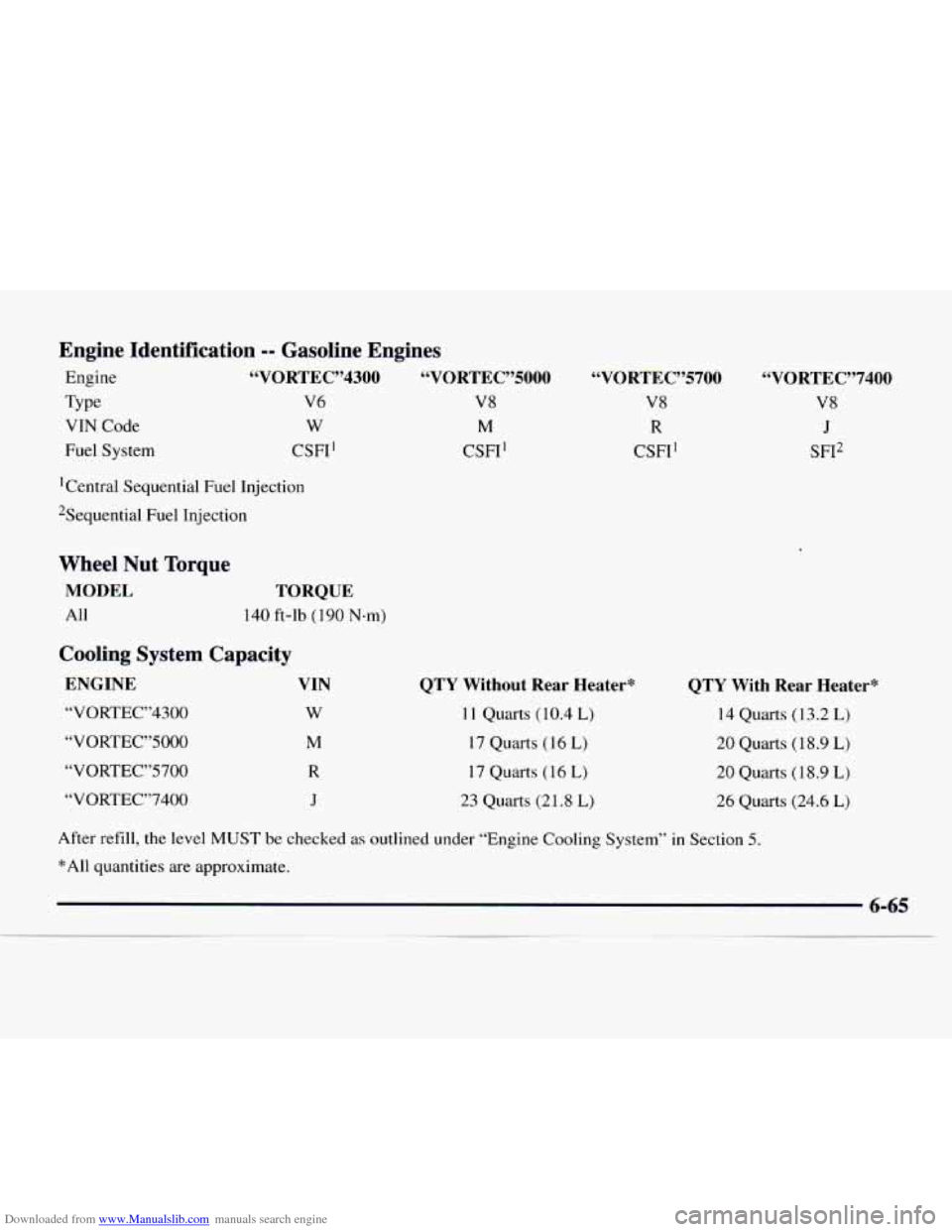
Downloaded from www.Manualslib.com manuals search engine Engine Identification -- Gasoline Engines
Type V6 V8 Engine
“VORTEC”4300 “VORTEC”5000
VIN Code W M
Fuel System CSFI~ CSFI 1
Central Sequential Fuel
Injection
2Sequential Fuel Injection
Wheel Nut Torque
MODEL
All
TORQUE
140 ft-lb (1 90 N-m)
Cooling System Capacity
ENGINE VIN
“VORTEC”4300 W
“VORTEC”5000 M
“VORTEC”5700 R
“VORTEC”7400 J
“VORTEC”5700
V8
R
CSFI 1
“VORTEC”7400
V8
J
SFI*
QTY Without Rear Heater*
1 1 Quarts (10.4 L)
17 Quarts ( 16 L)
17 Quarts ( 16 L)
23 Quarts (21.8 L)
QTY With Rear Heater*
14 Quarts (13.2 L)
20 Quarts (18.9 L)
20 Quarts (18.9 L)
26 Quarts (24.6 L)
After refill, the level MUST be checked as outlined under “Engine Cooling System” in Section 5.
*All quantities are approximate.
Page 352 of 386
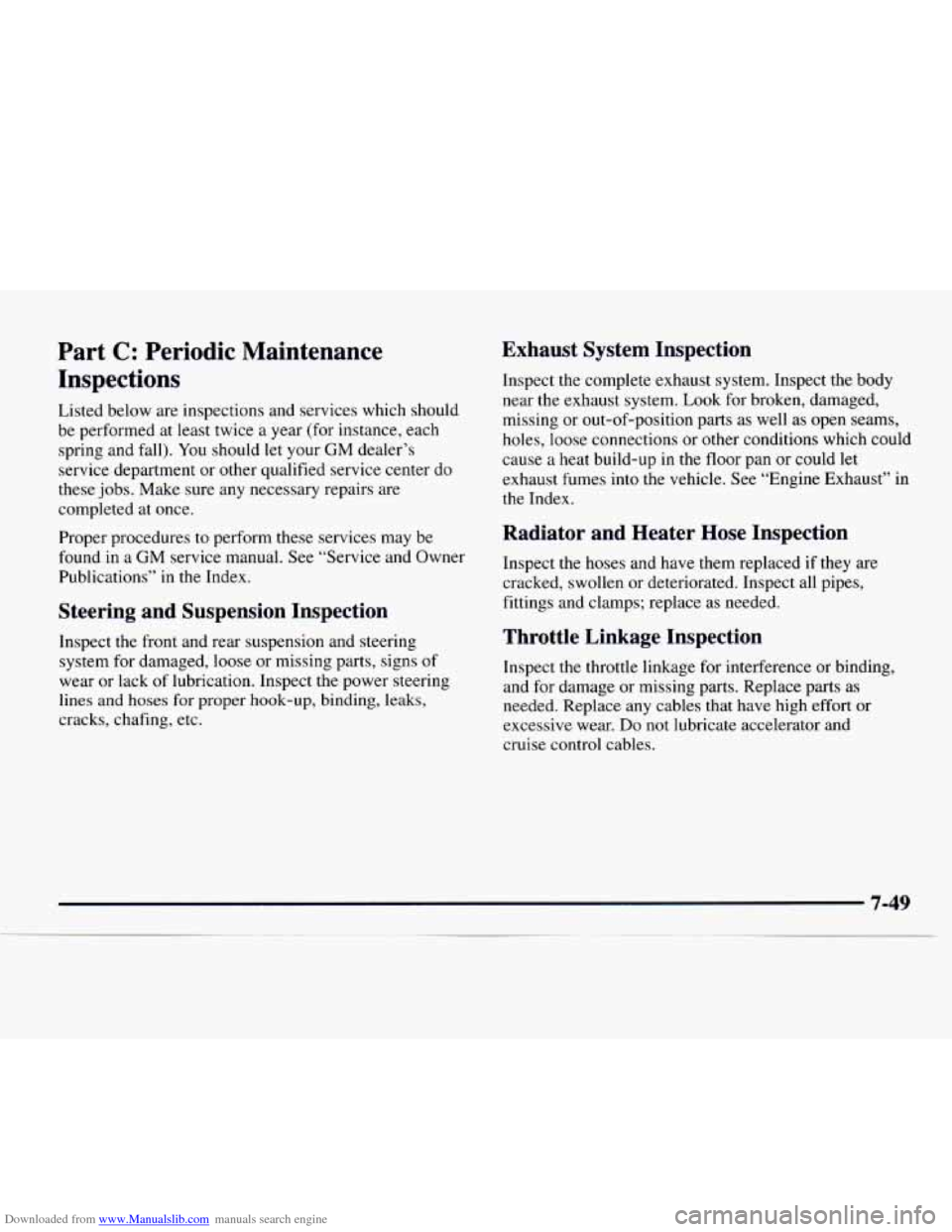
Downloaded from www.Manualslib.com manuals search engine Part C: Periodic Maintenance
Inspections
Listed below 3Elnspections and services which should
be performed at least twice
a year (for instance, each
spring and fall). You should let your
GM dealer’s
service department or other qualified service center do
these
jobs. Make sure any necessary repairs are
completed at once.
Proper procedures to perform these services may be
found in a
GM service manual. See “Service and Owner
Publications’’ in the Index.
Steering and Suspension Inspection
Inspect the front and rear suspension and steering
system for damaged, loose or missing parts, signs of
wear or lack of lubrication. Inspect the power steering
lines and
hoses for proper hook-up, binding, leaks,
cracks, chafing, etc.
Exhaust System Inspection
Inspect the complete exhaust system. Inspect the body
near the exhaust system. Look for broken, damaged,
missing or out-of-position parts as well as open seams,
holes, loose connections or other conditions which could
cause a heat build-up in the floor pan or could let
exhaust fumes into the vehicle. See “Engine Exhaust” in
the Index.
Radiator and Heater Hose Inspection
Inspect the hoses and have them replaced if they are
cracked, swollen or deteriorated. Inspect all pipes,
fittings and clamps; replace as needed.
Throttle Linkage Inspection
Inspect the throttle linkage for interference or binding,
and for damage or missing parts. Replace parts as
needed. Replace any cables that have high effort or
excessive wear.
Do not lubricate accelerator and
cruise control cables.
Page 378 of 386
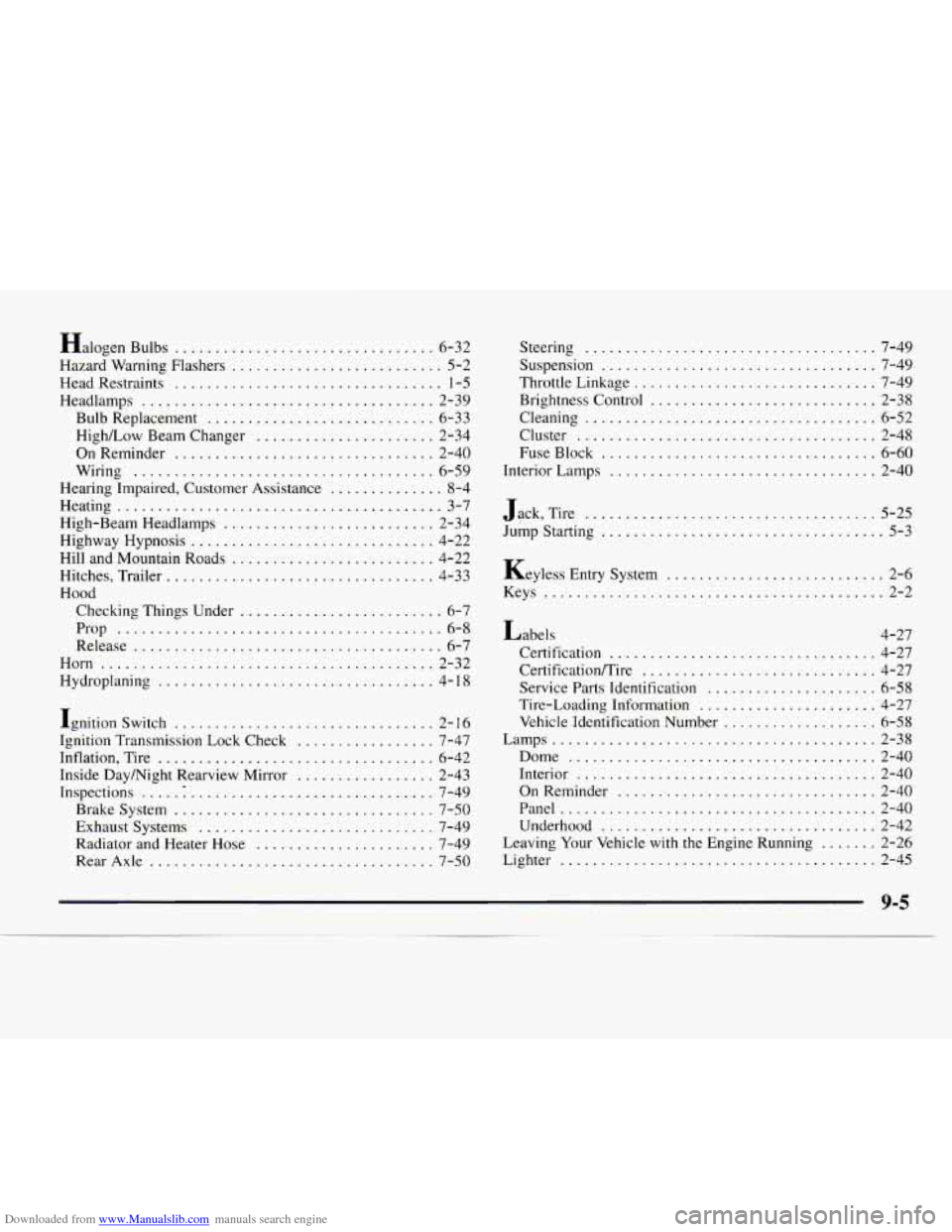
Downloaded from www.Manualslib.com manuals search engine Halogen Bulbs ................................ 6-32
Hazard Warning Flashers
.......................... 5-2
Head Restraints
................................. 1-5
Bulb Replacement ............................ 6-33
High/Low Beam Changer ...................... 2-34
OnReminder
................................ 2-40
Hearing Impaired. Customer Assistance
.............. 8-4
Heating
........................................ 3-7
High-Beam Headlamps
.......................... 2-34
Highway Hypnosis
.............................. 4-22
Hill and Mountain Roads
......................... 4-22
Hitches. Trailer
................................. 4-33
Hood
Checking Things Under
......................... 6-7
Prop
........................................ 6-8
Release
...................................... 6-7
Horn
......................................... 2-32
Hydroplaning
.................................. 4- 18
Headlamps .................................... 2-39
Wiring
..................................... 6-59
Ignition Switch
................................ 2- 16
Inflation. Tire .................................. 6-42
Inside Daymight Rearview Mirror
................. 2-43
Inspections
.................................... 7-49
Brakesystem
................................ 7-50
Exhaust Systems
............................. 7-49
Radiator and Heater Hose
...................... 7-49
RearAxle
................................... 7-50
Ignition Transmission
Lock Check
................. 7-47 Steering
.................................... 7-49
Suspension
.................................. 7-49
Throttle Linkage
.............................. 7-49
Cleaning
.................................... 6-52
Cluster
..................................... 2-48
FuseBlock
.................................. 6-60
Interior Lamps
................................. 2-40
Brightness Control
............................ 2-38
.................................... J ack. . Tire 5-25
Jump Starting ................................... 5-3
Keyless Entry System
........................... 2-6
Keys
.......................................... 2-2
Labels 4-27
Certification
................................. 4-27
Certification/Tire
............................. 4-27
Service Parts Identification
..................... 6-58
Tire-Loading Information
...................... 4-27
Vehicle Identification Number
................... 6-58
Dome
...................................... 2-40
Interior
..................................... 2-40
OnReminder
................................ 2-40
Panel
....................................... 2-40
Underhood
.................................. 2-42
Lalnps
........................................ 2-38
Leaving
Your Vehicle with the Engine Running ....... 2-26
Lighter
....................................... 2-45